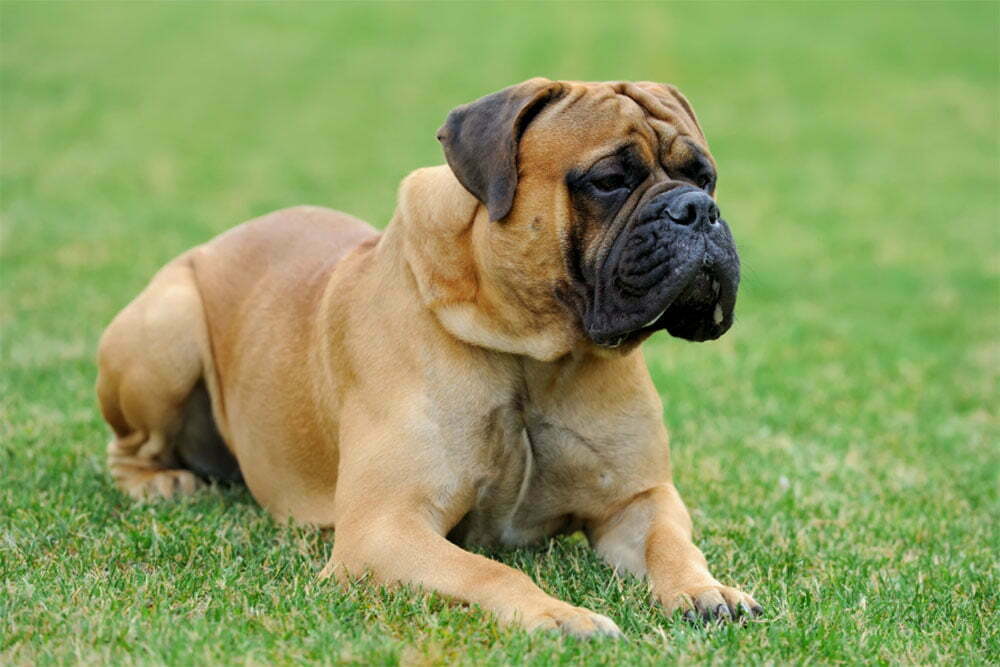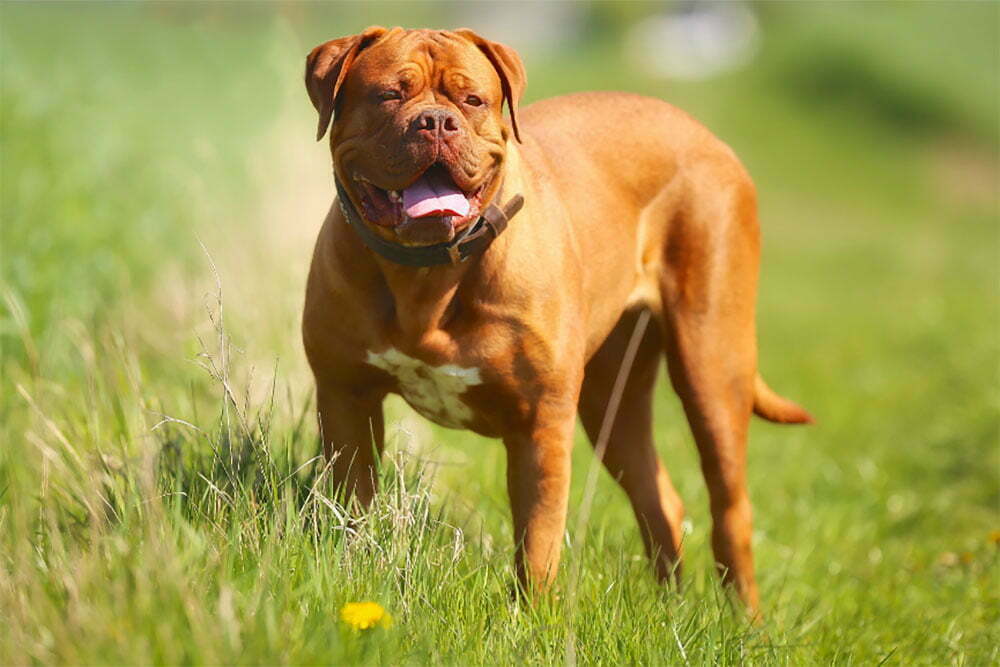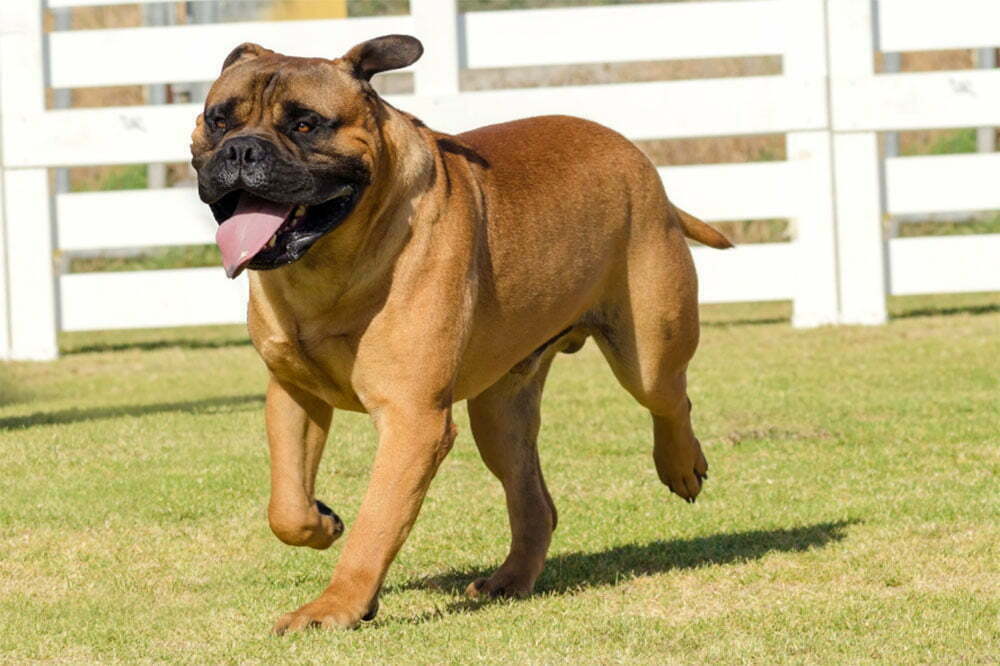Also known as the “Old English Mastiff”, mastiffs are big dogs with even bigger personalities.
Their size can make them seem quite intimidating, but if there’s one thing you need to know about this dog it’s that mastiffs are the gentle giants of the canine family.

If you’re thinking about getting a mastiff and you want to learn as much as possible about this beautiful breed before you do, you’ve come to the right place. Below, you’ll find a ton of information relating to the mastiff.
We’ll explore their trainability, look at whether or not they are a good choice for family homes, and go into detail about their care needs. In the end, you’ll have a much clearer idea of whether this is the right breed for you.
Key Facts
Average Lifespan
The average lifespan for a mastiff is between 10-12 years. This is the standard for a large dog. It’s also worth noting that this is the expected lifespan for a mastiff that doesn’t encounter any health issues, which is something we’ll get into a little later.
Minimum Exercise (per day)
You might think that a big dog like a mastiff needs as much exercise as possible throughout the day, but this isn’t the case. In fact, as a general rule, smaller dogs need a lot more exercise than large dogs.
The minimum amount of exercise a mastiff needs per day is just 40 minutes. However, this should be broken down into two different walks; one in the morning and one in the evening.
Coat Length
Mastiffs have short, dense coats that don’t require a lot of grooming. They do, however, require regular baths. Their coats typically come in three colors; apricot, fawn, and brindle.
Minimum Cost (per month)
Things you’ll need to spend money on to keep your mastiff healthy and happy every month include food, grooming equipment, toys, and monthly flea and worm medication. These things combined average around $100 per month.
Appearance
Size
Mastiffs are categorized as “Giant” dogs. You’ll need to be pretty strong in order to walk one, especially at first as they can have a tendency to pull on their leads.
You’ll also have to be confident enough to show a giant dog like a mastiff who’s boss when training and disciplining them.
Average Height
The average height of a mastiff depends on the sex. Male mastiffs can easily measure 30-inches (76cm) from the floor to their withers. Female mastiffs can reach up to 27.5-inches (70cm) using the same measurements.
Average Weight
Again, this depends on the sex of the mastiff. A healthy male mastiff can weigh anywhere between 150lbs – 250lbs. A healthy female mastiff’s average weight range would be between 120lbs – 180lbs.
This, combined with their height, goes to show why you’ll need to be strong in body and mind to manage a mastiff.
Temperament
Apartment Living
Given a mastiff’s sheer size, it’s safe to say that mastiffs don’t make the best choice for apartment living. They don’t mind being inside, but they do need to get up and stretch their legs throughout the day.
The average apartment is simply too small to allow for this and, if you are adamant that you want a mastiff but you live in an apartment, you should be prepared to walk them several times a day.
Good for Novice Owners
Mastiffs make an excellent choice of dog for novice owners. This is mostly because they have such easy-going personalities and because they are super affectionate.

They’re also highly intelligent, which means that a first-time dog owner should be able to train them quite easily.
Sensitivity Level
As mastiffs are so easy-going, they have an average sensitivity level. They won’t mind if their daily routine is changed every so often, and they won’t typically react negatively to loud music or people.
They aren’t affected emotionally by moderate punishment either, so there’s no need to worry about causing any lasting psychological damage if you need to gently discipline them.
However, this is a personal character trait for each individual dog, and some mastiffs won’t mind being sent to their beds, while others will be devastated by a stern telling-off!
Tolerates Being Alone
As puppies, mastiffs are prone to panic if they are left on their own for any length of time. This results in barking, howling, crying, and whining. However, mastiffs are intelligent dogs and they will soon learn to self-soothe and enjoy their own company as they mature.
Tolerates Cold Weather
Mastiffs have a preference for cold weather. This is mostly because they are larger dogs and, as such, they generate quite a lot of heat, particularly after they’ve been for a walk or played a game of fetch.
Their dense coats also make them better suited to cold weather conditions.
Tolerates Hot Weather
Mastiffs can tolerate a little hot weather but, due to their size and the density of their coats, they prefer to be kept cool. If the temperatures start to soar in the summer, it’s best to keep your mastiff indoors with the AC running.
They should also have access to fresh water whenever they need it. Some mastiffs also enjoy cooling off in the water, so walking them along a route with a river or stream in the summer would be another good idea.
Affectionate with Family
Despite looking like big, ferocious dogs, mastiffs are incredibly gentle and affectionate. They love nothing more than spending some quality time curled up on the sofa or playing with their family.
They are also considered excellent emotional support dogs. This is because they have an ability to form an incredibly strong bond with their owners and they’ll reflect your own emotions.
So, when you’re happy, they’re happy. And, when you’re feeling sad, they’ll show empathy.
Kid-Friendly
Their affectionate nature and playfulness make mastiffs a good choice for children, and they’ll enjoy running with them. They also have an average sensitivity level, so it’s unlikely that the loud noises and screaming that kids make will affect them negatively.
Their size is also another factor that makes them good with children. Unlike smaller dogs, a mastiff won’t feel threatened or snap when petted a little too hard.
However, this is something that is personal to each dog, and some may have a smaller tolerance for heavy-handed petting than others.
There’s something else that you’ll need to consider when it comes to mastiffs and children.
Again, this is to do with the sheer size. An overexcited mastiff may easily knock a child over if it runs into them or jumps up at them, which could cause an injury.
Dog Friendly
Mastiffs are generally friendly towards other dogs so they are a good choice if you’re thinking of bringing another dog into your home.
As always, there will be some sniffing and aggressive play while the dogs establish a pack hierarchy but, once this phase has passed, they’ll enjoy playing with their canine companions.
Friendly Toward Strangers
Since mastiffs reflect your own emotions, their friendliness towards strangers will really depend on how you’re dealing with the situation.
If you’re chatting happily with someone you’ve never met before, they’ll likely think that everything is fine. However, if you’re acting scared or upset, they are more likely to try and protect you.
The best way for a mastiff to build friendliness towards strangers is to socialize them from a young age. Take them out on walks to different places where they’ll encounter many different people. This will show them that strangers aren’t always something to be feared.
Health and Grooming
Shedding
Mastiffs shed a moderate amount of fur throughout the year, and this is a natural process of the hair growth cycle – much like humans lose hairs that are replaced with new growth.
A moderate amount of brushing will help to stop them from shedding, but a mastiff’s dense coat really responds better to regular bathing.
Drooling
If there’s one thing you need to know about mastiffs it’s that they are big droolers! If you don’t want to deal with dog slobber on your clothes or wiping it off your floors and walls when they shake themselves, a mastiff probably isn’t the right choice for you.
Grooming
There are a few aspects to consider when it comes to a mastiff’s grooming needs. First of all, they don’t need to be brushed very regularly. They do shed a moderate amount, but their coats are so dense that a brush isn’t the most effective tool to help manage this.
Instead, their coats respond much better to regular bathing. The lather and repeat cycle helps to loosen any dense hairs from their coats and washes them away.
However, you must make sure that you’re using a dog shampoo that is made with as many natural ingredients as possible. If you can get hypoallergenic shampoo, you’ll be doing even better!
A mastiff also needs to have its eyes and ears cleaned on a regular basis to help prevent infections. This can be done simply using warm water and a clean cloth, but you can also use specialist eye and ear wipes if you need to.
General Health
Mastiffs are generally healthy dogs who, if given the correct diet and exercise, have a life expectancy of between 10-12 years.
As with all dogs, mastiffs are susceptible to some common health problems (which we’ll discuss next) but if looked after properly and groomed regularly, you can prevent some of these from happening.
Common Health Problems
So, what are the common health problems that a mastiff could suffer from? The most common issue is bloat. This happens when their stomach fills with gas and begins to swell, putting pressure on their internal organs in the process.
If left untreated, bloat can lead to a twisted stomach, cutting it off from both the esophagus and small intestine.
Since mastiffs are giant dogs, they can also be susceptible to developing hip dysplasia.
This is caused by excessive wear of the hip joint cartilage and it can lead to arthritis (also known as degenerative joint disease or osteoarthritis). The best way to avoid this is to make sure you’re not over-exercising your mastiff.
Cystinuria is another common health problem, but it only affects male mastiffs. This is a genetic metabolic defect of the kidneys that prevents them from reabsorbing cystine (a type of amino acid) correctly.
When this happens, it crystallizes and forms kidney and bladder stones. These can cause urinary tract infections and potentially fatal blockages.
Potential for Weight Gain
A mastiff can gain too much weight very easily. However, this can be managed by feeding them the correct portion size and making sure they take their minimum exercise requirements each day.
If you feed them treats, these should be counted as a part of their daily caloric intake.
Trainability
Easy to Train
Mastiffs are intelligent and, therefore, they are relatively easy to train. As with all puppies, they can be challenging at first but as they start to develop a bond with their owner they start to make more progress with their training.

Consistency is key, and the more time you spend training them the easier they’ll find it to learn new skills and commands.
Intelligence
Training a mastiff is made easy due to the fact they are intelligent dogs. On average, they’ll learn and memorize a new command in around 25-40 repetitions, which is pretty good compared to some other breeds.
However, it’s essential that you take full advantage of their intelligence for training. If you don’t, they soon learn how to call upon it for naughty behavior!
Potential to Bite
While mastiffs are generally gentle, affectionate dogs, they may bite if they feel threatened or provoked.
They also have a herding instinct that may result in nipping and, if they get overexcited, they may mouth at you without realizing the strength of their jaws and teeth. However, for the most part, a mastiff won’t bite without a good reason.
Tendency to Bark or Howl
Mastiffs are renowned for being fairly quiet dogs. They’ll bark if they feel threatened or if they feel the need to raise an alarm, but they don’t tend to use barking or howling as a way of getting attention or alleviating boredom.
History
The history of the mastiff goes back much further than you might think. In fact, there is evidence of mastiffs dating back as far as 2500 BC! Bas-reliefs found in the Babylonian Palace of Ashurbanipal in Asia depict mastiffs hunting lions in the desert near the Tigris River.
These are now on display in the British Museum.
They also have a history in battle, and Marco Polo wrote of Kubla Khan who reportedly had a kennel of 5,000 mastiffs that were used for hunting and war. When Hannibal crossed The Alps, he’s also said to have taken several battalions of war-trained mastiffs with him.
Mastiffs were used as fighting dogs against wild animals in the Elizabethan era, usually for the entertainment of Queen Elizabeth I.
Skip forward a few hundred years and, by the 1920s, mastiffs were almost extinct.
This is mainly because their numbers started declining during World War I, when it was considered ‘unpatriotic’ to keep a dog alive who ate as much as a soldier. As a result, entire kennels filled with mastiffs were euthanized.
One hundred years later, and mastiffs are now, luckily, one of the best-loved breeds in the world.
They are renowned for their gentle, affectionate personalities and their loyalty. They also have mass appeal as they are gentle enough to be around children, yet large enough to deter any potential intruders!
Costs
The initial cost of buying a mastiff will ultimately depend on where you get it from. Breeders can cost anywhere from $850 – $1,700 depending on the puppy’s lineage.
Mastiffs rescued from shelters, however, will be much less expensive and you’ll usually only have to pay a donation fee of around $100-$200.
The real cost comes when you get your mastiff home. Every month, you’ll need to purchase food, grooming products, toys, and flea and worm medication. This can easily total $100, making the ongoing annual costs of owning a mastiff around $1,200.
Fun Facts
- Pugs have mastiff blood in them and were originally described as a form of dwarf mastiff.
- There is evidence to suggest the Mayflower had a mastiff and a spaniel on board. However, it wasn’t until the late 1800s that the real importation of mastiffs into the United States began.
- The name “mastiff” is a shortened version of their full name “The Old English Mastiff”.
- The record of “The World’s Largest Dog” once belonged to a mastiff named Zorba. He set the record in November 1989 at the age of 8, measuring 37-inches high at the shoulder and 8 ‘3” from his nose to the tip of his tail. He also weighed an astonishing 343 lbs!
- The puppy phase for mastiffs is much longer than any other breed of dog, and they don’t reach full physical or mental maturity until around the age of 3 years old.
